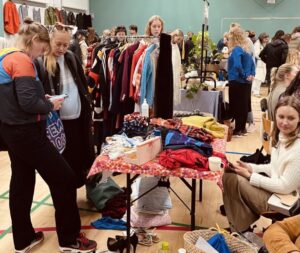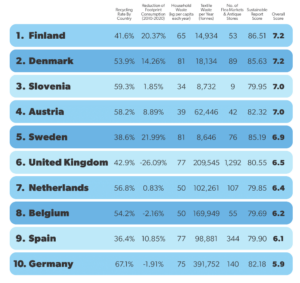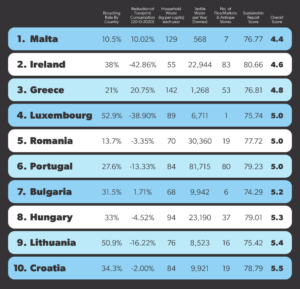
The items we all consume has an enormous impact on our environment. Worldwide consumption and production, a driving force of the global economy, rests on the exploitation of the natural environment and its resources in a way that continues to have destructive impacts on the planet.
The fast-growing production of fashion clothes requires more natural resources to grow cotton or for livestock to produce wool, cashmere or leather exploiting our forest, land and water resources. Chemicals used in dyes and processing are polluting rivers while harming ecosystems and people’s health. Despite fashion being a trillion dollar industry, workers in developing countries continues to face low wages and unsafe working conditions. On the opposite side of production, we deal with an increasing waste accumulation as we are wearing clothes for a shorter time, resulting in millions of tons of cast-offs going to landfills each year.
Furthermore, a significant factor driving the degradation of the environment is the lack of consumer awareness and the fashion industry’s frequent release of new items in fast fashion spoiling customers with loyalty programmes and discounts encouraging them to return. In many instances, the fashion companies fail in telling its customers how and where something is produced although often claiming to be acting responsibly.
Claiming its brands are made from “sustainably sourced materials”, H&M has released over 18 new clothing collections just in 2022 continuing to contribute to the fast fashion industry and throwaway culture.
One might state the fact that it would suit designers and fast-fashion brands to place themselves at the forefront of promoting sustainable fashion and engage in the conversation of what it could look like, but let’s leave it at that for now.
The responsibility of consuming responsibly is left with the consumers and the attempt avoiding plastic packaging where possible and implement more sustainable shopping patterns, shoppers are increasingly adopting more eco-friendly habits and British Savoo has researched which European countries lead the way.
Savoo, an online fundraising platform raising money for charity every time its users search the internet, has researched and ranked the 30 most populous European countries to determine where the most sustainable shoppers live. The platform ranked the countries based on the metrics Sustainable Development Report ranking, recycling rate, consumption footprint, textile-, household- and food waste per capita, and the number of flea/street markets and antique stores.
The Sustainable Development Report Ranking measures the total progress towards achieving all 17 SDG Goals with the specific score showing the percentage of SDG achievement. A score of 100 indicates full achievement of all SDG’s.

Finland
As seen above, Finland takes the lead as the home of the most sustainable shoppers in Europe sitting at the top of the SDG achievement ranking of all 193 UN member states with a staggering 86.51 out of a possible 100.
Further, Finland reduced its consumption footprint by 20.37% between 2010 and 2020 being the fourth biggest reduction after Italy (26.03%), Sweden (21.99%) and Greece (20.75%).
The country falls slightly behind in offering eco-conscious shoppers a chance to purchase pre-loved produce at discount prices at flea markets and antique stores with 53 of these outlets in total compared to the country’s population of 5.540.720.
Denmark
Denmark place itself as the runner-up and follows Finland close with a Sustainable Development score of 85.63 out of 100 while recycling more than half of its waste (53.9%) in 2020 and shrinking its consumption footprint by 14.26% between 2010 and 2020.
Relative to waste generation in other European countries, textile waste is relatively low in Denmark with the country producing 18.134 tonnes each year. In comparison, Italy was the leading textile polluter in 2016 with nearly 466 thousand tonnes of textile waste followed by Germany, France and the UK with over 200 thousand tonnes textile disposed.
Denmark’s second-hand scene, extending the life cycles of textiles and contributing to a more circular fashion industry, takes the lead with 89 outlets. Denmark has a population of 5.910.577.
Slovenia
Slovenia claims the throne on low household waste generation (numbers) with an estimated produce of 34 kg. At the same time, the country recycles 59.3% of its total waste and decreased its consumption footprint by 1.85% from an already low 1.64% in 2010 down to 1.61% in 2020.
However, the country ranks fifth lowest in flea markets and antique stores with only nine of such outlets.
Sweden
After Italy, Sweden has seen the most significant consumption footprint reduction which has dropped by 21.99% – from 2.17% to 1.74% – over the last ten years.
The country ranks third in SDG achievement with a score of 85.19 out of 100 and produces a textile waste level of 8.646 tonnes each year.
United Kingdom
Of all countries analysed, and with 1.300 outlets available, the UK has the highest amount of flea markets and antique shops relative to its population number of almost 68 million.
The country also claims 11th place in SDG achievement with a score of 80.55 and a recycling rate of 42.9%.
Europe’s least sustainable shoppers
Where there’s a top, there’s also a bottom.

Malta
Claiming the position of 33rd in SDG achievement with a score of 76.77 out of 100, Malta ranks as one of the worst countries for sustainable shopping. The country’s recycling rate was only 10.5% of its total waste in 2010 and shoppers can choose between only seven flea markets and antique stores.
Nonetheless, and perhaps as a result of the country’s small population size (441.543), it produced only a total amount of textile waste of 568 tonnes despite producing 129 kg.
Ireland
In contrast to its big brother, Ireland ranks second from the bottom having not reduced, but increased, its consumption footprint by -42.86% in the ten years leading up to 2020, which is the overall largest percentage increase of any of the analysed countries.
As a part of the investigation, Savoo has further more dived into an investigation of the most popular brands to shop second-hand(ly) by analysing 30 top brands across four online second-hand market places.
Although being one of the most polluting fast fashion companies in the world, Zara should thanks its fans for making it the most popular second-hand brand overall with fast fashion clothing brand H&M in second place and sportswear brand Adidas ranking third (link below).
Shopping sustainably can make a huge difference to the planet and there’s never a better time for implementing green and sustainable shopping habits. Thinking about how far the product you are buying has travelled to reach the shelves and from where the items are sourced, is as non-transparent as it could be, but tryin to make the effort is a start.
Source: https://www.savoo.co.uk/
Statistics on waste generation in EU: https://www.statista.com/statistics/1090540/textile-waste-generated-in-the-european-union/
Sustainable Development Goals: https://sdgs.un.org/






One Comment on “Finland and Denmark tops list of most sustainable shoppers in EU”